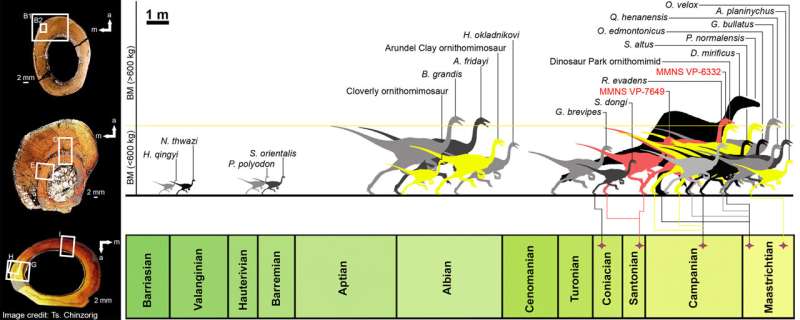Ostrich-like dinosaurs found in Mississippi are among the world's largest ornithomimosaurs at more than 800 kg

Ostrich-like dinosaurs called ornithomimosaurs grew to enormous sizes in ancient eastern North America, according to a study published October 19, 2022, in the open-access journal PLOS ONE by Chinzorig Tsogtbaatar of the North Carolina Museum of Natural Sciences and colleagues.
During the Late Cretaceous Period, North America was split by a seaway into two landmasses: Laramidia to the west and Appalachia to the east. But fossils from Appalachia are rare, and therefore ancient ecosystems from this region are poorly understood. In this study, Chinzorig and colleagues describe new fossils of ornithomimosaur dinosaurs from the Late Cretaceous Eutaw Formation of Mississippi.
Ornithomimosaurs, the so-called "bird-mimic" dinosaurs, were superficially ostrich-shaped with small heads, long arms, and strong legs. The new fossils, including foot bones, are around 85 million years old, making them a rare glimpse into a poorly known interval of North American dinosaur evolution
By comparing the proportions of these fossils and the patterns of growth within the bones, the authors determined that the fossils likely represent two different species of ornithomimosaurs, one relatively small and one very large. They estimate the larger species to have weighed over 800 kg, and the individual examined was likely still growing when it died. This makes it among the largest ornithomimosaurs known.
These fossils provide valuable insights into the otherwise poorly understood dinosaur ecosystems of Late Cretaceous eastern North America. They also shed light on ornithomimosaur evolution; giant body sizes and multiple species living side-by-side are recurring trends for these dinosaurs across North America and Asia. Further study will hopefully elucidate the reasons behind the success of these life strategies.
The authors add, "The co-existence of medium- and large-bodied ornithomimosaur taxa during the Late Cretaceous Santonian of North America does not only provide key information on the diversity and distribution of North American ornithomimosaurs from the Appalachian landmass, but it also suggests broader evidence of multiple cohabiting species of ornithomimosaurian dinosaurs in Late Cretaceous ecosystems of Laurasia."
Chinese fossil eggs show dinosaur decline before extinction
More information: Large-bodied ornithomimosaurs inhabited Appalachia during the Late Cretaceous of North America, PLoS ONE (2022). DOI: 10.1371/journal.pone.0266648
Journal information: PLoS ONE
Provided by Public Library of Science
No comments:
Post a Comment